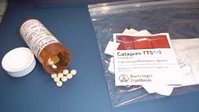Pediatric clonidine poisoning as a resuit of pharmacy compounding error.
Suchard JR, Graeme KA.
Pediatr Emery Care 2002;18:295-296.
Both of these authors are physicians: one is affiliated with the University of California Irvine Medical Center, Orange, California, and the other is with the Good Samaritan Regional Medical Center, Phoenix, Arizona. They describe two cases in which children being treated with clonidine for psychiatric indications presented at emergency rooms with several common features of clonidine overdose. In addition, both presented with headache, a symptom not widely reported in earlier reports of pediatric clonidine toxicity. Regarding Case 1, the patient, a 9-year-old boy, had taken the first dose of a new clonidine prescription the night before his visit to the emergency room. His new prescription, which was compounded at a local pharmacy, was different in color and flavor than was his previous prescription and was ". . . labeled to indicate an equivalent nightly clonidine dose of 0.05 mg in 2-mL volume." His previous prescription had been ". . . dosed at 0.05 mg (0.5 mL of 0.1 mg/mL solution) at bedtime." The concentration of clonidine in the new prescription was determined by gas chromatography/mass spectometry and compared with a standard clonidine preparation of known concentration. "The clonidine concentration was 2168.6 (mu)g/mL versus the drug label that indicated 25 (mu)g/mL, an 87-fold dosing error. The pharmacy that compounded this prescription was alerted to the error, and the parents discarded the remainder of the new bottle."
In Case 2, a 10-year-old boy was being treated by a psychiatrist with clonidine 0.1 mg every morning and 0.05 mg every evening. "This prescription was compounded at a local pharmacy by combining immediate-release and sustained-release clonidine preparations and placing the mixture within gelatin capsules. The patient's mother suspected a potential dosing error since the new capsules were a different color from the patient's usual prescription." Capsules from both the previous and new prescriptions were analyzed using gas chromatography/mass spectometry. The old prescription was found to contain 0.0193 mg clonidine per capsule and the new prescription was found to contain 0.198 mg clonidine per capsule, a 10-- fold difference. (The authors believe that the error may have been at least partly due to the misplacement of a decimal point during pharmaceutical calculations.) The local pharmacy was contacted about the error.
Copyright International Journal of Pharmaceutical Compounding Mar/Apr 2003
Provided by ProQuest Information and Learning Company. All rights Reserved



